As summer hits, so does the sudden desire for all things mineral sunscreen. And for good reason: Sunscreen is one of the most important daily skincare products for protection against the elements and premature aging. If you’ve been hanging around here long enough, you know that natural sunscreen is at the top of our list. These are our top picks for the best mineral sunscreen for the whole family.
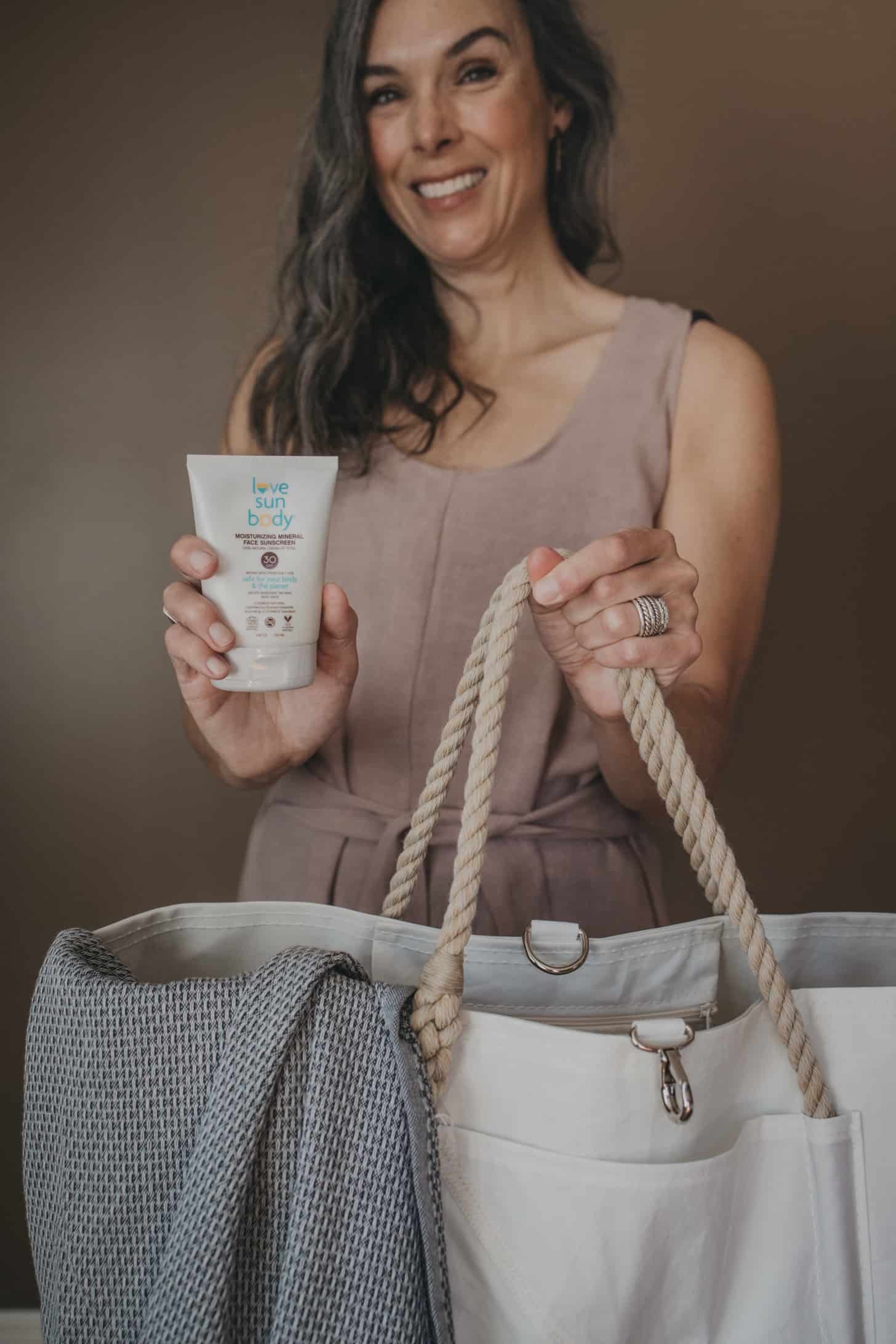
By: TNK Team
IN THIS POST:
- What to consider when buying mineral SPF
- Best overall mineral sunscreen
- Best drugstore mineral sunscreen
- Best mineral SPF for families
While we’re not going to chide you if you haven’t been wearing your face SPF all year round, we will say that if you plan on spending more time outdoors now that the temps are rising, you need a go-to mineral sunscreen. And not one of those SPFs that turns you into a lifeguard circa 1962 (though no shade thrown to the zinc-covered nose—slathering that on was a way to be proactive!).
Instead, we’ve sourced our favorite mineral sunscreens for your body that aren’t reminiscent of Casper the Friendly Ghost. But first, a few things you should know about buying natural sunscreen.
What to consider when buying mineral sunscreen
Picture this: Summer has hit and suddenly it’s full of walks to the park, long weekend afternoon playdates and plans to head to the pool (or lake or ocean). The timing creeps up on you and you’re left choosing between a fast trip to the store for a new bottle of sunblock and an angry red sunburn.
There are innumerable options with colorful bottles, cute logos and enticing coconut-y scents. So, which do you choose when you’re stuck in a bind? Well, you can start here, with our guide to reading sunscreen labels.
But if you don’t have time for that, you can skip to our quick guide for what to consider when shopping for natural sunscreen. 👇
Active Ingredients
Active ingredients are the ingredients that will actually block UVA and UVB rays from your skin. These fall into two buckets: chemical barriers and mineral barriers.
- Chemical barriers include ingredients like avobenzone, octocrylene, octinoxate, octisalate and oxybenzone.
- Mineral barriers include zinc oxide and titanium dioxide.
Hot Tip: You really want to only see one thing on the label here and that’s zinc oxide or zinc oxide + titanium dioxide in tandem.
Zinc oxide provides more broad spectrum coverage than titanium dioxide and it also doesn’t introduce potential health risks, or threats to coral reefs (1) like chemical barriers do. Even the FDA recommends (2) zinc and/or titanium dioxide as the safest sunscreen options.
Plus, while most people think about sunscreen as UV protection, mineral sunscreen can also protect against blue light and pollution (talk about a triple whammy!).
Additional questions you can ask brands/check labels for:
- Is their zinc oxide is also non-nano (providing the best UV protection)?
- And is their zinc oxide non-coated (meaning no added silicone or silicone derivatives)?
RELATED: Get more detail + examples for how to vet your sunscreen in this chemist-reviewed post, or get our recommendations for the best mineral face SPF.
Inactive Ingredients
Inactive ingredients are the carrier ingredients for each formula (like what makes a lotion a lotion or a spray a spray). In conventional sunscreens, you will see ingredients to consider like synthetic fragrances, microplastics, PEGs, mineral oils and parabens.
We recommend choosing a sunscreen that is not only void of questionable ingredients, but is also formulated to support skin health.
For example, look for sunscreens that are jam-packed with antioxidants, which significantly further reduce the rise of UV damage to skin cells (3). Some examples of antioxidant-rich ingredients you may find in sunscreens are:
- Ferulic acid
- Oryzanol
- Vitamin C
- Neem
- Rosemary
- Pumpkin seed oil
- Squalane
- Tocopherol
RELATED: Check out TNK’s NO THANKS list for all the ingredients we skip in our personal care products.
Packaging
We’ve seen several options for SPF packaging including glass, tins, paper tubes and, of course, plastic.
If you are buying SPF in plastic, look for plastic that is either made from recycled plastic or easily recyclable plastic.
Two examples are: polyethylene terephthalate (RPET), which is the most widely recycled plastic in the world, or High Density Polyethylene (HDPE), which is the easiest plastic polymer to recycle, according to the Plastic Action Center (4).
Of course, it doesn’t really matter how recyclable the plastic is if your local recycling program does not have the capacity to process it. So, a to-do for your list: Be sure to call your local program to inquire.
We also love seeing companies that are cleaning up our oceans by using recycled ocean plastic in their packaging—as well as some brands that give back to Mother Earth via programs like One Tree Planted or via obtaining a Carbon Neutral Certification.
Third Party Certifications
Lastly, another measure you can use to help you determine if your sunscreen is a healthier choice is via third party certifications like MADE SAFE, EWG VERIFIED, USDA Certified Organic or ECOCERT.
Knowing that a brand has taken the extra steps of having an independent third party look at their formula speaks volumes to their ethos and transparency.
But (you knew there was a but, didn’t you?), it’s not always that cut and dry, as some certifications apply to sunscreen more than others. For example, the FDA does not define or regulate the term “organic” as it applies to cosmetic, body care or personal care products. So although USDA organic sunscreens do exist, you won’t see many. We recommend looking for ECOCERT Cosmos Natural as the gold standard when it comes to third-party certs.
RELATED: What do they mean?! How to decipher beauty certifications.
Best mineral sunscreen overall
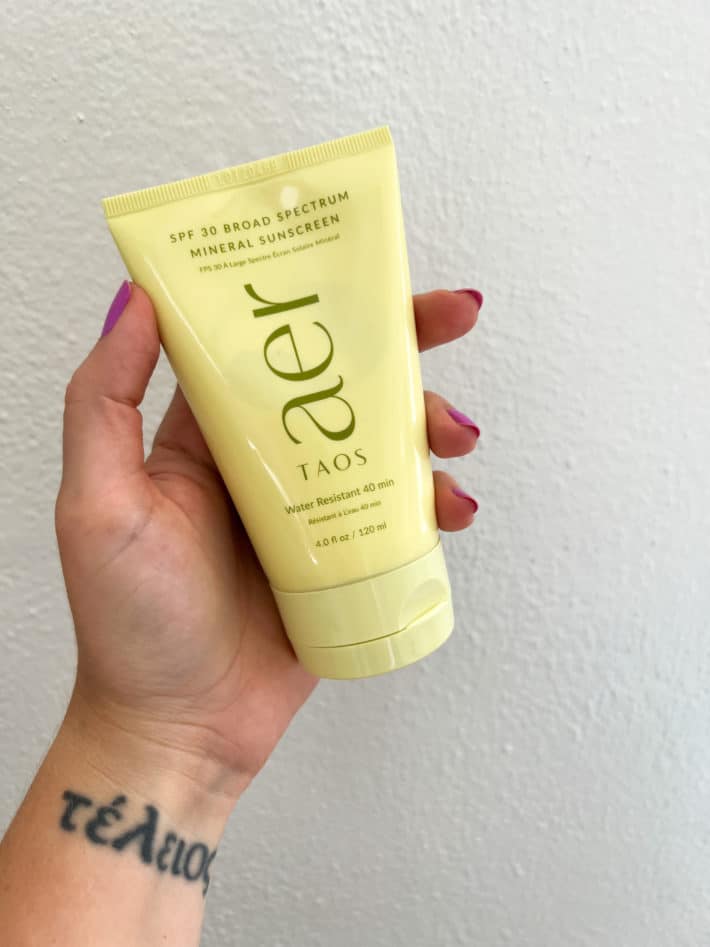
Taos AER SPF 30 Broad Spectrum Mineral Sunscreen | $38
This is by far the creamiest mineral SPF we tried. It’s easy to rub in, contains non-nano zinc at 20% and is water resistant for up to 40 minutes. We love how seamless it is to use, and it walks the fine line between great-for-everyday and great-for-a-beach-day. Not many SPFs can pull double-duty like that.
Speaking of double-duty, so many of the inactive ingredients in this formula are working HARD to support skin while protecting it. Plant oils like sunflower and pomegranate provide hydration and nourishment, while also creating a physical barrier on the skin. The zinc in the Taos is designed to have an invisible, dry finish, so you don’t have to worry about a greasy feel or a chalky appearance. The non-nano zinc is also reef and ocean safe.
And while we get a bit of a whiff of your standard zinc-oxide scent, what’s more standout is the earthy blend of essential oils blended to create a woodsy aroma that doesn’t overpower. A win-win-win.
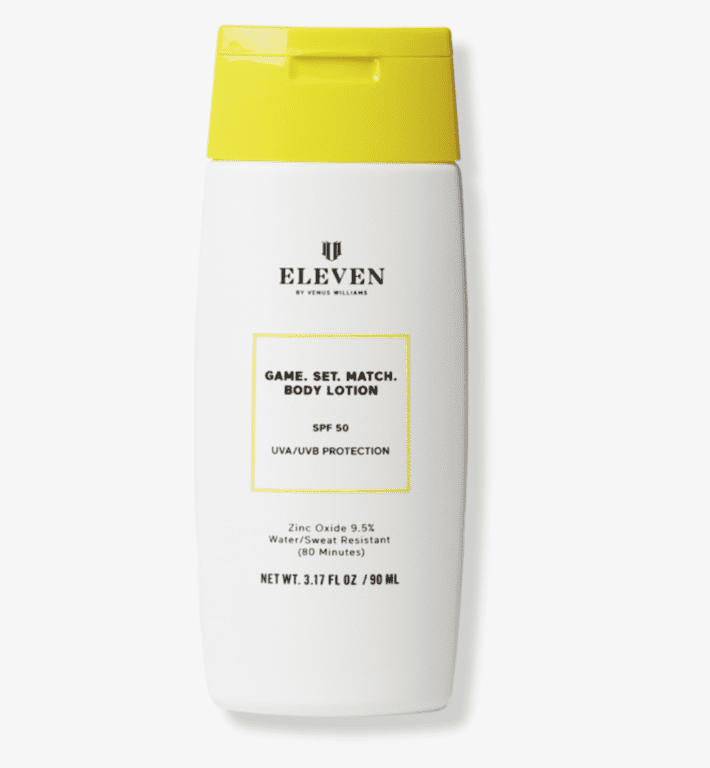
EleVen Game Set Match Body Lotion SPF 50 | $38
Another home run (er, we guess another game, set, match) in the creamy SPF department is Venus Williams’ SPF 50 body lotion. We didn’t expect to like this line as much as we did (it also has a great face SPF serum), but it rubs in easily with no white cast. The low zinc oxide content of it (9.5% to many other SPFs’ 40%) probably has something to do with that.
While the additional ingredients in this formula are just fine by our standards, there’s nothing super stand-out about them either. But the SPF itself is reef-safe, offers physical protection from UVA and UVB rays, and has packaging made from 100% PCR and recyclable materials.
That, in combo with the fact that this lotion is as good for a beach day (or tennis workout) as it is for everyday use, make it a top pick.
Readers love it too
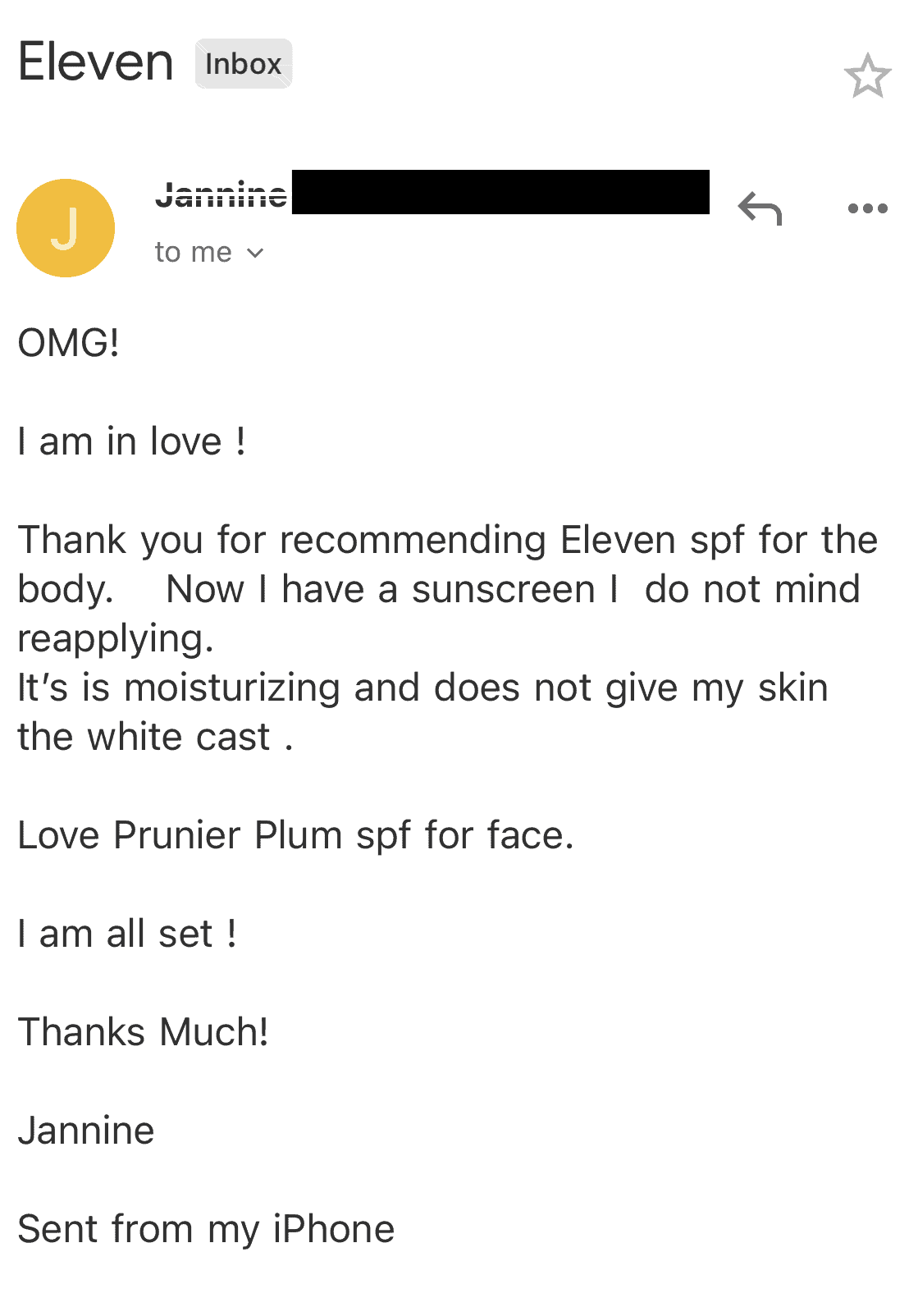
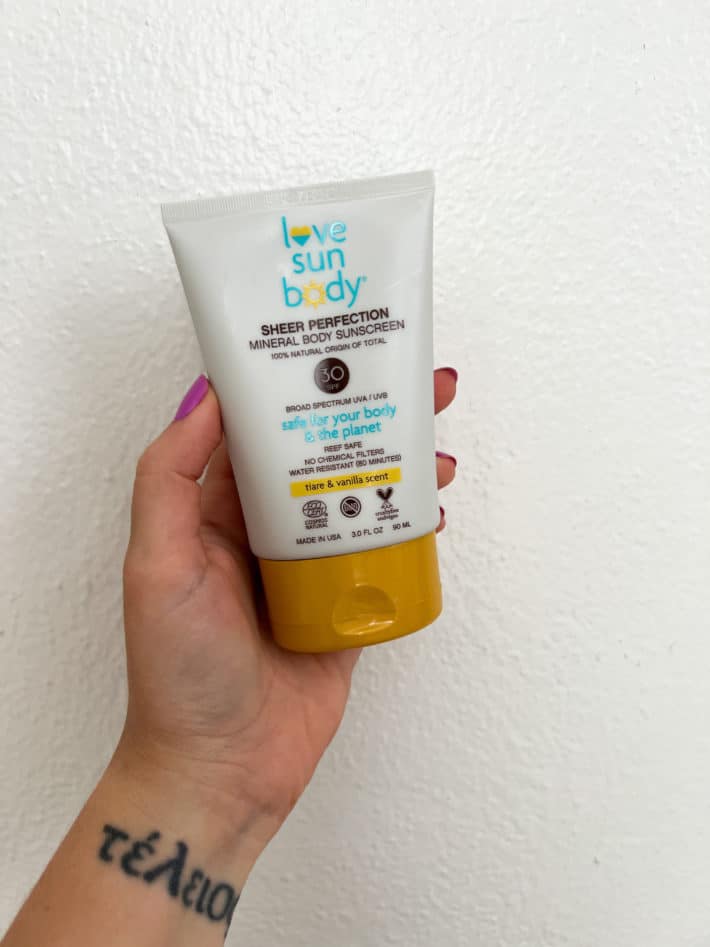
Love Sun Body SPF 30 Tiare and Vanilla Scent | $28
Love Sun Body’s mineral sunscreens are the first and only sunscreens in the U.S. certified by ECOCERT Cosmos Natural. They’ve also been clinically tested to be hypoallergenic, non-comedogenic, PETA cruelty-free certified, vegan and reef safe.
In addition, LSB products are made with the safest UVA and UVB filters—AKA non-nano zinc oxide.
They also have a simple ingredient list that includes nourishing elements like almond oil and vitamin E. These formulas pump out white yet blend easily to clear, have a moisturizing matte finish and are water-resistant (80 minutes).
Family-friendly, easy to use and packaged in recyclable plastic, these SPFs just work and are a responsible choice for sun protection. Basically, if you’re looking for the most high-quality ingredients, this is the SPF for you.
We love the vanilla-scented option but there is also a fragrance-free option if you prefer.
Best drugstore mineral sunscreen
If you need an SPF stat and only have access to a drugstore, these are the ones we’d recommend picking up on the go. We’d also skip the following brands, which might have mineral sunscreen options, but we don’t love the inactive ingredients: Sun Bum, Supergoop and Bare Republic (not to mention the traditional brands’ versions of mineral sunscreens).
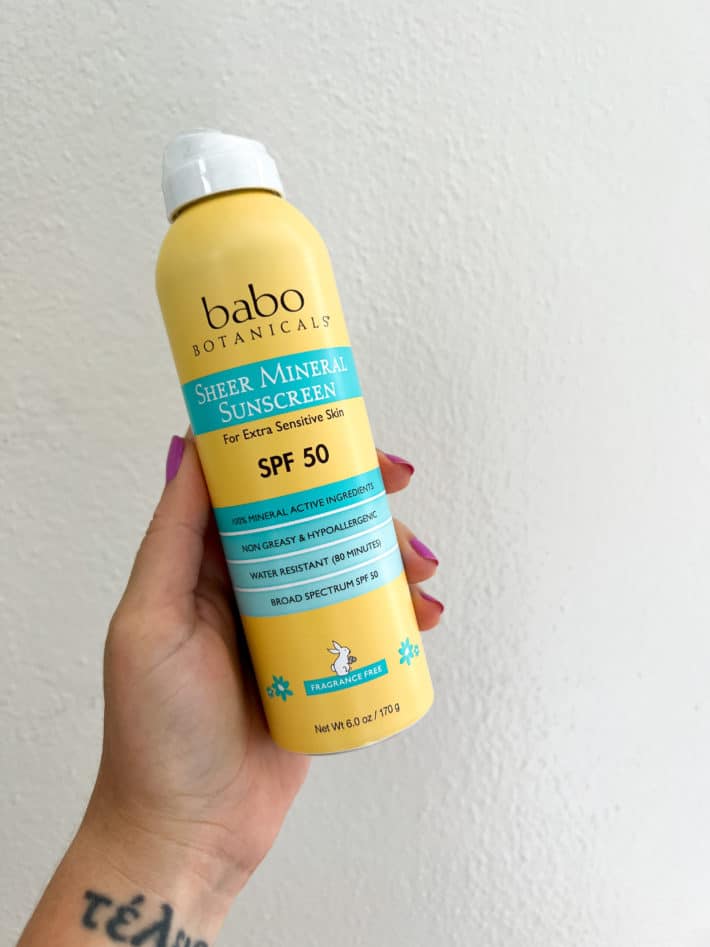
Babo Botanicals Sheer Mineral Sunscreen Spray SPF 50 | $22
We love this as a family-friendly option for a couple of reasons. First, Babo Botanicals is available on-the-fly at most Target and Ulta stores. Second, they offer one of the very few #TNKapproved spray options—as well as a full line of SPFs for face, body, baby and more.
Babo is also B Corp certified, which is a huge feat for brands and speaks to the brand’s environmental responsibility and sustainability commitments.
And Babo formulates with calming ingredients like aloe leaf juice and calendula—both of which make a perfect compliment to long days in the sun.And as with the previous brands, Babo is also vegan, Leaping Bunny certified cruelty-free, and reef safe. Our favorite, the Sheer Mineral Sunscreen Spray SPF50, sprays out white and needs rubbing in after spraying, but will rub into a mostly sheer finish.
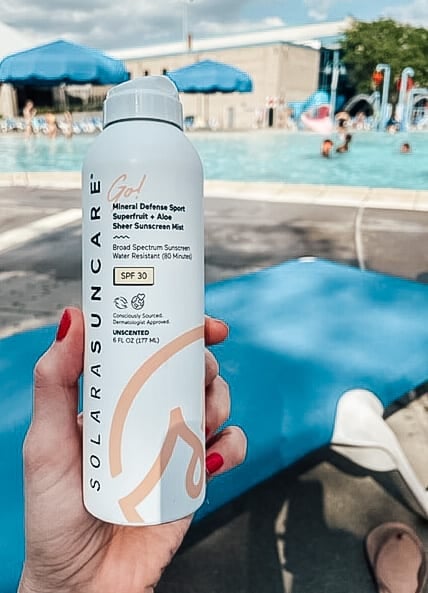
Solara Go! Mineral Defense SPORT Superfruit + Aloe Sunscreen Mist, SPF 30 | $18
Solara is not only raising the bar with their adaptogen and plant-powered SPF, this North American manufactured line is also 100% recyclable including the caps and pumps and housed in FSC Certified 100% recycled outers. Their products are reef safe and formulated with incredible ingredients.
We chose this particular product—The Go! Mineral Defense SPORT Superfruit + Aloe Sunscreen Mist—because it’s unscented, non-aerosol, sensitive-skin friendly and 100% Mineral Broad Spectrum SPF 30 with 80 Minutes Water Resistance. Try their new Go! line (it’s available at Target) and thank us later. Also it rubs in clear with minimal effort.
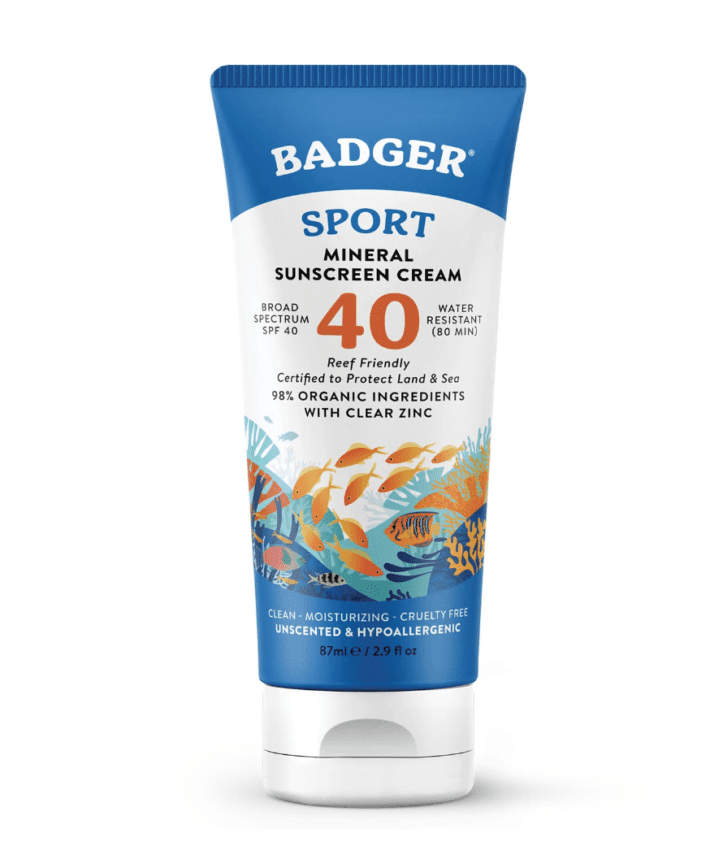
Badger Sport Mineral Sunscreen Cream – SPF 40 | $15.50
Another brand you can find at Target (and definitely at Whole Foods, though that’s not what we’d classify as a “drugstore”) is Badger. This was one of the first SPFs we tried when going mineral with our SPF and it stands the test of time.
This one in particular has 98% organic ingredients, on top of being reef safe, broad spectrum, water resistant and non-nano clear zinc (which is not sheer but wears less white than regular zinc). And those 98% organic ingredients? THERE ARE ONLY 4 OF THEM. Yep, four total ingredients in an SPF 40. How do they do it?
It’s a waterless formula, so expect it to be a bit thicker, but it’ll still rub in fairly easily. It’s also packaged in a 50% PCR tube, and made with solar power.
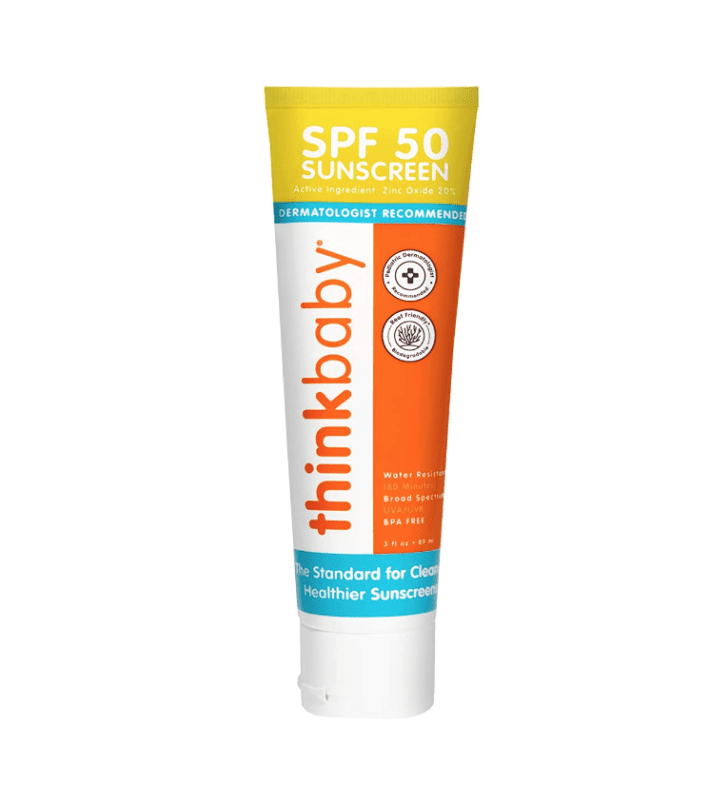
thinkbaby Mineral Baby Sunscreen SPF 50 | $14.50
Another brand that’s available at many Target stores, thinkbaby and thinksport are great mineral SPF choices. The brand itself is EWG Verified, cruelty free, reef safe and made in the US, and the thinkbaby options seem to be the most in-store available.
Many times, a formula developed specifically for the babes contains fewer ingredients overall, making it a perfect pick even for adults. We love this one for its ability to rub in fairly easily, its relatively simple ingredient list and its accessibility. Plus, it’s broad spectrum, water resistant and uses non-nano zinc.
Best mineral sunscreen for families
If it’s more than just you in your household and you need volume as much as you need accessibility and ease of use, these picks are for you. We reach for them for our families again and again.
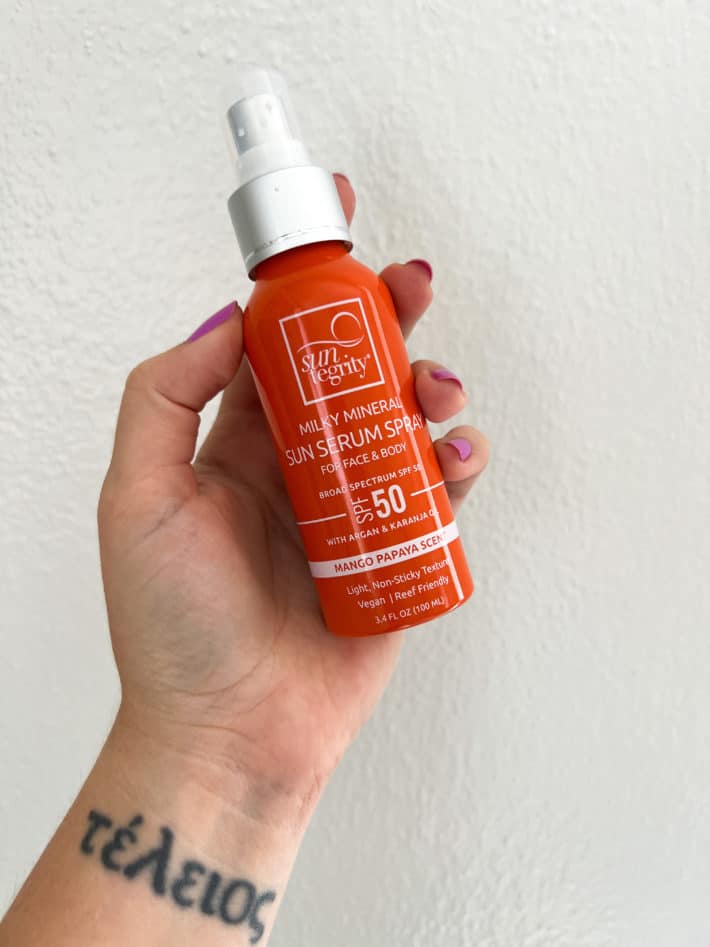
Best Spray SPF: Suntegrity Milky Mineral Sun Serum Spray SPF 50 | $48
Let’s start with this caveat about the best mineral sunscreens for families: Spray sunscreens are COVETED when you’re trying to wrangle SPF onto kids too excited about the pool to stand still. But no matter which mineral spray sunscreen you choose, you’re not going to get the seamless spray experience you will from a chemical sunscreen. You just won’t.
What you will get is an easier-to-apply process, with each of these sprays coming out white and being fairly easy to rub in.
We chose Suntegrity’s as the best in the spray category for a number of reasons, including that it’s vegan and cruelty free; it comes in a recyclable aluminum bottle; and it contains a few great skin-boosting ingredients like argan, squalene and karanja oils.
But most importantly, it’s the easiest to rub in of the sprays, and it has a light tropical scent that’s reminiscent of beach days.
With respect to price and accessibility, the Babo Botanicals Sheer Mineral Sunscreen SPF 50 we mentioned above and Baby Skin Mineral Sunscreen Spray (non-aerosol and GREAT for the littlest littles) are also good choices, though they’re harder to rub in (Kristy’s kids use the SPF 50 to play abominable snowman at the pool after applying…).
Save: Code THENEWKNEW15 will save you 15% on your first order at The Detox Market.
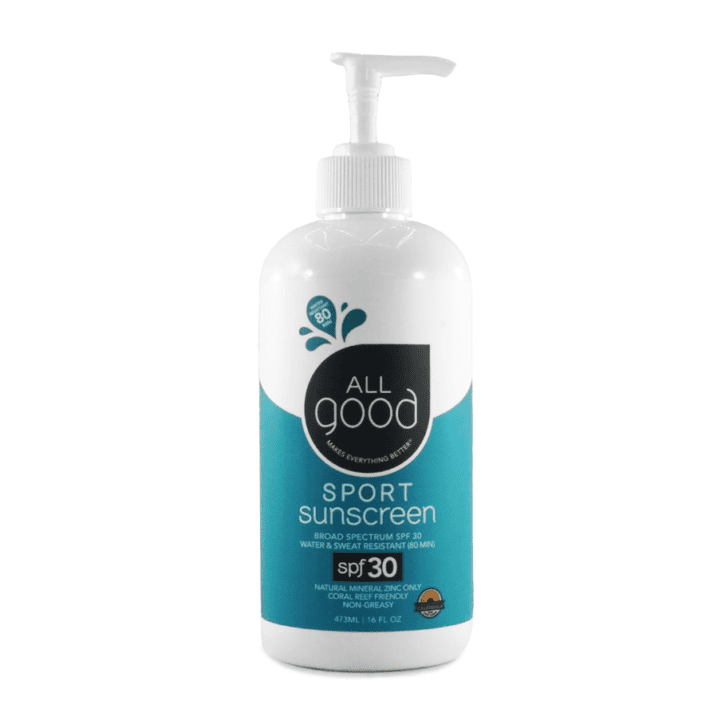
Best family size: ALL GOOD SPF 30 Mineral Sport Sunscreen | $49
If your kids are very outdoorsy or swim-focused and you need the jumbotron of mineral SPFs, the best value is the ALL GOOD family size bottle. It’s 16 oz., which is massive compared to the 3 and 6 oz. we see other brands offer.
And this SPF works. It’s called a “sport” for a reason—it’s got broad spectrum UVA/UVB protection and is water-resistant, while being extra hydrating, easy to rub in, and without leaving your skin chalky or greasy.
BONUS: This co. is B Corp certified, which is a huge feat for brands and speaks to the brand’s environmental responsibility and sustainability commitments. So it should go without saying that this SPF is also reef and ocean friendly. The brand is also Climate Neutral Certified, so you can feel good about your purchase.
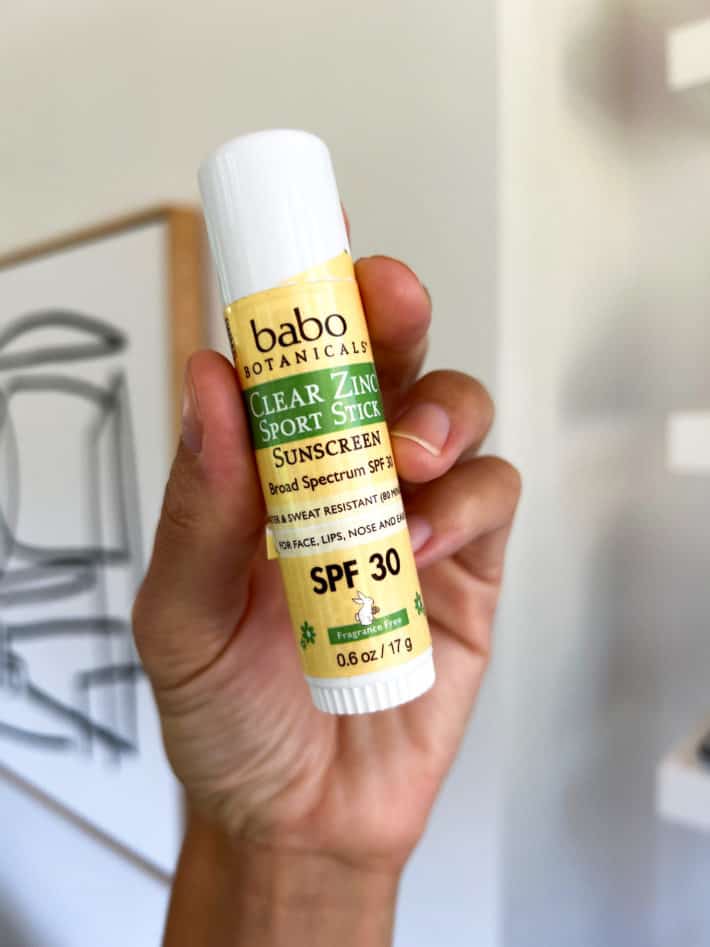
Best stick SPF: Babo Botanicals Clear Zinc Sport Stick | $12.99
The Babo Botanicals line has an edge with their “clear zinc.” It’s not completely sheer but it does go on sheerer than regular non-nano zinc—and we completely see a difference. The base of this formula is solid enough that it doesn’t apply goopy but soft enough that it rubs in easily.
Also love the size. This slimmer tube is more fit for faces and kids because it can hit smaller parts of the body with precision and ease. I also like the .6 oz fill here because it’s more likely to use it all up in a season or two before it expires (two year shelf-life).
And as far as ingredients go, this 80-minute water and sweat resistant formula delivers a ton of USDA certified ingredients including skin-loving oils like avocado, jojoba and shea. And it’s truly “fragrance free” with just the natural scent of zinc. Also, third party verified for safety by MADE SAFE.
A few more best natural sunscreen recs
We also love recommending Raw Elements’s plastic free line, and we can get on board with Native’s Unscented Mineral SPF 30 (skip the scented options, as the brand doesn’t disclose what’s in their fragrance).
For more, check out tips on how to read sunscreen labels, our top picks for eco-friendly sunscreens and our top picks for tinted face SPF!
What’s your favorite body SPF?

TNK Team Note: This article contains affiliate links. TNK uses affiliate links as a source for revenue to fund operations of the business and to be less dependent on branded content. TNK stands behind all product recommendations. Still have questions about these links or our process? Feel free to email us.
REFERENCES:
1. Bever, Lindsey; Washington Post; Climate and Environment, Hawaii just banned your favorite sunscreen to protect its coral reefs; July 6th, 2018
2. FDA Proposes Sunscreen Regulation Changes, February 2019
3. Yim S, Lee J, Hae J, Scholten J, Willingham R, Nicoll J, Baswan SM. Chrysanthemum Morifolium Extract And Ascorbic Acid-2-Glucoside (AA2G) Blend Inhibits UVA-Induced Delayed Cyclobutane Pyrimidine Dimer (CPD) Production In Melanocytes. Clinical, Cosmetic, and Investigational Dermatology. 2019;12:823. | 2. Rojas JO, Londoño CE, Ciro YH. The health benefits of natural skin UVA photoprotective compounds found in botanical sources. Int J Pharm Pharm Sci. 2016;8(3):13-23. | 3. Lorigo M, Cairrao E. Antioxidants as stabilizers of UV filters: an example for the UV-B filter octylmethoxycinnamate. Biomedical Dermatology. 2019 Dec 1;3(1):11. | 4. Leccia MT, Béani JC. Protection by Antioxidants Against UV-Induced Damage. Trace Elements and Free Radicals in Oxidative Diseases. 1994 May 30:233
4. Plastic Action Centre; Plastic Marketplace, Infographic; Plastic by the numbers

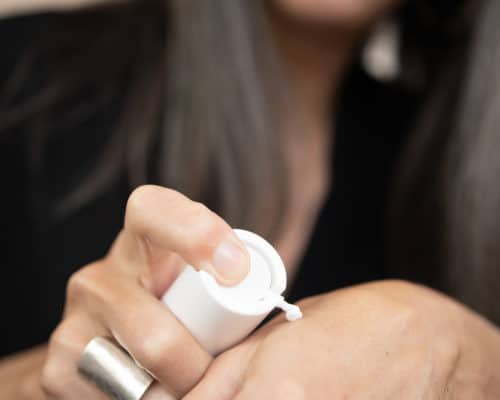
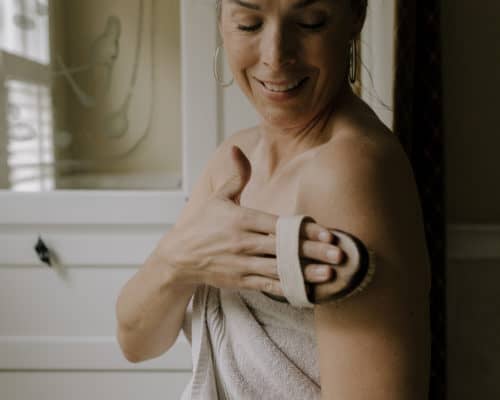
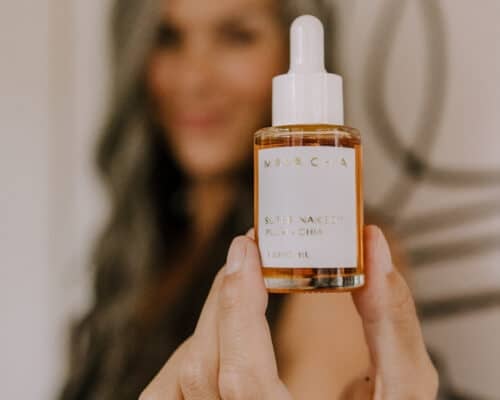
Bella
July 13, 2022This is a terrific, thorough, and helpful review – thank you. What do you recommend for faces at the beach? Looking for one for myself and one for the family. And what do you recommend for faces in daily city life? I read your review of tinted face sunscreens, however I don’t care for tinted because it gets on my towels and masks…If you can point me in a good direction we leave for the beach this weekend!! Thanks a bunch!
Lisa Fennessy
August 6, 2022Hi Bella! I would recommend checking out this post – we detail out best face SPFs for everyday and also the beach too. City life you want to protect against pollution but zinc does that and that’s the active ingredient in all of these SPFs so you are covered for that automatically. Hope this helps! xo, Lisa
Jacquie
February 17, 2023Hello. This is a great article with lots of options. Gotta say, there is info that those spray sunscreens are not good for your lungs. I’d look more into this infor before buying one of those.
Lisa Fennessy
April 22, 2023Conventional sprays are not good for your lungs and I would not recommend using those. When it comes to clean spray options, there is some research that shows breathing in titanium dioxide presents health concerns. Both of the sprays we’ve recommended in this post do not contain titanium dioxide. Hope this helps. xo, Lisa
Nicole
June 24, 2023Love this article!
I was a bit confused when I saw the EWG score of 8 for the ELEVEN game set match. Could you help clarify this.
Thank you!
Lisa Fennessy
July 25, 2023Hi Nicole! The EWG is a good tool to use to get a basic idea of products but it is by far perfect. In this situation that happens to be the case too. I talked to Kate, our contributing cosmetic chemist and she clarified; The peels oils (both a 7 and drive this rating up) are likely the extracts of the extracts available to cosmetic chemists that have had the FCF compounds removed. There are so many varietals / options of citrus peel oils available to chemists through large companies, it’s not hard to find. Even lay people can find FCF-free citrus peel oils. In addition, the c13-15 Alkane on the marketplace is derived from sugarcane. It’s also knowns as “hemisqualane” or “the lighter squalane.” This ingredient is labeled a 5 here which Kate does not think is fair. Taking those three out of the equation, this formula would potentially average a 3 if we were to look at it again through this lens. Hope this helps! Lisa